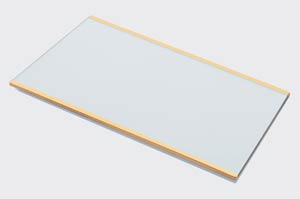What is Physical vapour deposition ?
Physical vapor deposition (PVD) is fundamentally a vaporisation coating technique, involving transfer of material on an atomic level. It is an alternative process to electroplating. Physical vapour deposition (PVD) processes involve depositing a source material (which can either be from a solid, liquid or gas) onto the surface of the component. There may be a chemical reaction between the substrate and the coating material. One of the attractions of PVD methods is that the substrate can be at relatively low temperatures (in the range 50–500°C).
Physical Vapor Deposition
The process is similar to chemical vapour deposition (CVD) except that the raw materials/precursors, i.e. the material that is going to be deposited starts out in solid form, whereas in CVD, the precursors are introduced to the reaction chamber in the gaseous state.
Basic Principle of PVD
Physical vapor deposition (PVD) is a variety of vacuum deposition and is a general term used to describe any of a variety of methods to deposit thin films by the condensation of a vaporized form of the desired film material onto various workpiece surfaces (e.g., onto semiconductor wafers). The coating method involves purely physical processes such as high temperature vacuum evaporation with subsequent condensation, or plasma sputter bombardment rather than involving a chemical reaction at the surface to be coated as in chemical vapor deposition. The term physical vapor deposition appears originally in the 1966 book Vapor Deposition by CF Powell, JH Oxley and JM Blocher Jr, but Michael Faraday was using PVD to deposit coatings as far back as 1838.
Variants of PVD include, in order of increasing novelty:
- Cathodic Arc Deposition: In which a high power electric arc discharged at the target (source) material blasts away some into highly ionized vapor to be deposited onto the workpiece.
- Electron beam physical vapor deposition: In which the material to be deposited is heated to a high vapor pressure by electron bombardment in “high” vacuum and is transported by diffusion to be deposited by condensation on the (cooler) workpiece.
- Evaporative deposition: In which the material to be deposited is heated to a high vapor pressure by electrically resistive heating in “low” vacuum.
- Pulsed laser deposition: In which a high power laser ablates material from the target into a vapor.
- Sputter deposition: In which a glow plasma discharge (usually localized around the “target” by a magnet) bombards the material sputtering some away as a vapor for subsequent deposition. Here is an animation of a generic PVD sputter tool: PVD Animation
PVD is used in the manufacture of items including semiconductor devices, aluminized PET film for balloons and snack bags, and coated cutting tools for metalworking. Besides PVD tools for fabrication special smaller tools mainly for scientific purposes have been developed. They mainly serve the purpose of extreme thin films like atomic layers and are used mostly for small substrates. A good example are mini e-beam evaporators which can deposit monolayers of virtually all materials with melting points up to 3500°C.
The component that is to be coated is placed in a vacuum chamber. The coating material is evaporated by intense heat from, for example, a tungsten filament. An alternative method is to evaporate the coating material by a complex ion bombardment technique. The coating is then formed by atoms of the coating material being deposited onto the surface of the component being treated.
What are PVD Coatings Used For ?
PVD coatings are deposited for numerous reasons. Some of the main ones are :
- Improved hardness and wear resistance
- Reduced friction
- Improved oxidation resistance
The use of such coatings is aimed at improving efficiency through improved performance and longer component life. They may also allow coated components to operate in environments that the uncoated component would not otherwise have been able to perform.
Advantages of the Physical Vapour Deposition Process :
- Materials can be deposited with improved properties compared to the substrate material
- Almost any type of inorganic material can be used as well as some kinds of organic materials
- The process is more environmentally friendly than processes such as electroplating
Disadvantages of the Physical Vapour Deposition Process :
- It is a line of sight technique meaning that it is extremely difficult to coat undercuts and similar surface features
- High capital cost
- Some processes operate at high vacuums and temperatures requiring skilled operators
- Processes requiring large amounts of heat require appropriate cooling systems
- The rate of coating deposition is usually quite slow
You might also like
| How Does Chemical Vapour Deposition (CVD) Work ? Chemical Vapour Deposition (CVD) Chemical... | What is “Thin Films” materials ? Advanced Materials : Thin Films Thin film... | What is Sputter Deposition ? Sputtering Deposition Sputtering is a process... | What is Indium Tin Oxide? Indium Tin Oxide Indium tin oxide (ITO,... |

 Alloy Suppliers
Alloy Suppliers
 Aluminum
Aluminum
 Aluminum Extrusions
Aluminum Extrusions
 Copper-Brass-Bronze
Copper-Brass-Bronze
 Nickel
Nickel
 Magnets
Magnets
 Stainless Steel
Stainless Steel
 Stainless Steel Tubing
Stainless Steel Tubing
 Steel Service Centers
Steel Service Centers
 Titanium
Titanium
 Tungsten
Tungsten
 Wire Rope
Wire Rope